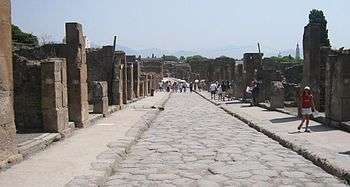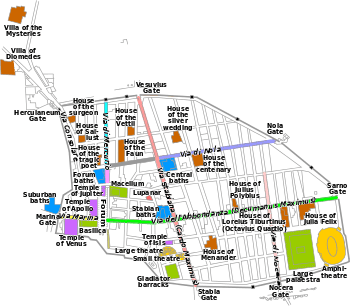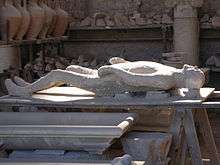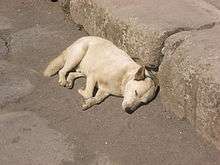Pompeii
Pompeii is in Campania, Italy, not far from Naples. Its major attraction is the ruined ancient Roman city of the same name, which was engulfed by Mt. Vesuvius in AD 79. This is a UNESCO World Heritage Site.


Understand
- See also: Roman Empire
Romans took control of Pompeii around 200 BC. On August 24, 79 AD, Vesuvius erupted, burying the nearby town of Pompeii in ash and soot, killing 20,000 people, and preserving the city in its state from that fateful day. Pompeii is an excavation (It: scavi) site and outdoor museum of the ancient Roman settlement. This site is considered to be one of the few sites where an ancient city has been preserved in detail - everything from jars and tables to paintings and people was frozen in time, yielding, together with neighbouring Herculaneum which suffered the same fate, an unprecedented opportunity to see how the people lived two thousand years ago.
Tickets
One-day tickets are €11 per adult; €5,50 for EU citizens between 18 - 24 and school teachers; EU citizens below 18 or above 65 get in for free (valid proving age document needed). A five-site pass costs €20. This includes Herculaneum and is valid for 3 days. As entrance to Herculaneum is also €11 buying this ticket saves you €2 even if you do not visit any of the other sites. The "Campania ArteCard", which costs €30 offers free admission to numerous sites in the region if you are planning to be in Campania for several days. The site is open daily from 8:30 to 19:30 (November to March from 8:30 to 17:00) and the last ticket is sold 90 minutes before closing. It is closed on 1st January, 1st May, and 25th December. Telephone: 081-857-5347.
Audioguides are available either at the train station InfoPoint or at the official entrance for €6,50, €10 for two, ID is required. They are not available at the secondary Eastern entrance by the Amphitheatre - which is the entrance nearest the modern day town centre if you are walking. Unofficial audio guides are on offer at one of the market stalls near this entrance. Take note that audioguide maps are not the same and the official audioguide comes with more audio points of interest. It's a good idea to check out both options before deciding. Pompeii may take several hours to explore so make sure to ask about the audioguide battery life before your purchase. Tour guides also cluster near the entrance and offer their services. It's a good idea to talk to one for a couple of minutes before deciding, to make sure you can understand their accent when they speak English. You can join a tour group with the train station InfoPoint for €12 (not including entrance fee) or €10 at the official entrance.
Get in
For transport in the area see Campania.
By train
It takes 30 to 40 minutes to get to Pompeii from either Naples or Sorrento. One-way tickets from any Trenitalia station within Naples city limits cost €2,80 as per January 2018. Pompeii is serviced by three train stations.
National train operator Trenitalia has one station called Pompei in the Napoli-Salerno regional line. This station is located south of the modern town. Getting out of the station, look for the impressive bell tower of the Shrine of the Blessed Virgin of the Rosary of Pompei (Italian: Pontificio Santuario della Beata Vergine del Santo Rosario di Pompei) and follow the main avenue (Via Sacra) heading north for a 3-minutes walk to Piazza Anfiteatro. There you will find one of the three entrances to the ruins, and the EAV bus stop for direct trip to the summit of Mt Vesuvius. If you are not willing to walk, taxi drivers at the train station will offer to take you to the entrance for around €10.
The Circumvesuviana railway, operated by EAV, has two stations in the village. On the Napoli-Poggiomarino line, the Pompei Santuario station is north of the modern village, very close to the Shrine of the Blessed Virgin. On the Napoli-Sorrento line, the small station called Pompei Scavi-Villa dei Misteri is about 50 m away to the main entrance to the ruins. Being the closest, it is the most frequented station by visitors, and it can be overcrowded at closing time when everybody gets out and rush for the trains to come back to Napoli. Timetables for the Circumvesuviana railway are available on this link.
At Pompei Scavi-Villa dei Misteri you can leave your bags for €1,50 (collect by 7:00 PM in summer, 6:00 PM October to February), or leave them for free at the ruins (pick up by 7:20 PM). There is also a Tourist Information office just down the street.
- The cheapest way to get here from Rome is to take the special train from Termini (each way is 10.50 Euros) or the regular train (each way is 22 Euros, 29 for first class) to Naples, then go down the escalator to the Circumvesuviana and buy a ticket to Pompei Scavi (1.80 Euro).
- From Salerno you can take the regional Trenitalia service to Napoli mentioned above, and get out at the Pompei station. One-way tickets from Salerno cost €2,40 as per January 2018, and the journey takes 45 minutes.
By bus
SITA runs buses from Naples. The cost is the same as the train.
By boat
If you are on a cruise, you can set up an excursion to explore the ruins (bus transfer) and tickets and tour will be included. From the cruise boat a hydrofoil travels around the Bay of Naples to Capri, Sorrento and Pompeii (from Naples). A bus-shuttle will take you to the ruins.
Disability
Disabled travelers should aim for the entrance at the Piazza Anfiteatro, where an itinerary has been designed to meet the needs of visitors with reduced mobility (and of parents with strollers, too!). Beware of the main entrance at Porte Marina, for it has plenty of stairs.
Get around
This is a walking site only. There are a few bicycles for rent, but the surfaces make them rather impractical. Walking the old Roman stone roads can be quite exhausting, especially in the heat of summer with loads of fellow tourists about. Everyone will be walking on cobblestones and uneven ground. The temperature is between 32° and 35°C in the summer. Make sure to take plenty of water and watch your step as the old roads have grooves in them where the carts ran. It is advisable to wear good footwear, sunscreen and hats. There is a lot to look at and in a full day, you still won't see everything.
On buying your ticket you should receive a map of the site and a booklet listing the main attractions. However, these can be sometimes out of print or you may find that the only booklet available is in Italian. A map of the site is essential if you want to see a lot in as short a time as possible. Even with a map visiting Pompeii is a bit like a trip to a maze. Many of the roads, apparently open according to the map, turn out to be blocked off for excavations or repairs, or, as happened in 2010, because a building collapsed. You might think you are heading for the exit but then have to turn around and retrace your steps to find another route.
See



.jpg)

- 🌍 Amphitheatre (Anfiteatro). This is in the most easterly corner of the excavated area, near the Sarno Gate entrance. It was completed in 80BC, measures 135 x 104 metres and could hold about 20,000 people. It is the earliest surviving permanent amphitheatre in Italy and one of the best preserved anywhere. It was used for gladiator battles, other sports and spectacles involving wild animals.
- 🌍 Great Palaestra (Gymnasium). This occupies a large area opposite the Amphitheatre. The central area was used for sporting activities and there was a pool in the middle. On three sides are lengthy internal porticos or colonnades.
- 🌍 House of the Vettii (Casa dei Vettii). This is believed to have been the home of two brothers who were freed slaves and became very affluent. It contains many frescoes. In the vestibule there is a striking fresco of a well-endowed Priapus, God of Fertility and among the frescos in other parts of the building are illustrations of couples making love, of cupids and of mythological characters.
- 🌍 House of the Faun (Casa del Fauno). This is named after a statue of a dancing faun found on the site. It is considered to be an excellent example of the fusion of Italian and Greek architectural styles, and occupies an entire block.
- 🌍 Forum. This was the center of public life, although it is now in the southwestern part of the excavated area. It was surrounded by many of the important government, religious and business buildings.
- 🌍 Temple of Apollo. This is to the north of the Basilica on the western side of the Forum. It has the oldest remains discovered, with some, including Etruscan items, dating back to 575BC, although the layout we see now was later than that.
- 🌍 Theatre. Theatre built in the hollow of a hill for acoustic advantage; it seated 5,000.
- Via dei Sepolcri (Street of Tombs)). A long street with worn ruts from carts.
- 🌍 Lupanar. An ancient brothel with pornographic frescoes over the entrance to each room, presumably indicating the services on offer. Even allowing for the smaller size of ancient Romans the beds seem rather small.
- House of the Ancient Hunt. Attractive, open-style house with many frescoes of hunting scenes.
- 🌍 Basilica. This is to the west of the Forum. It was the most important public building of the city where both justice was administered and trade was carried on.
- Forum Granary. Artifacts like amphorae (storage jars) and plaster casts of people who did not escape the eruption are stored in this building, which was designed to be the public market but may not have been finished before the eruption.
- 🌍 Baths. There are several baths to be inspected. The Forum Baths are just north of the forum and close to the restaurant. They are well-preserved and roofed. Be careful not to miss them as the entranceway is a long passage with no indication of the delights inside. The Central Baths occupy a much larger area but are less well-preserved. Close to these are the Stabian baths which have some interesting decorations and give a good idea of how baths used to function in Roman times.
- 🌍 House of the Tragic Poet (Casa del Poeta Tragico). This small atrium house is best known for the mosaic at the entrance depicting a chained dog, with the words Cave Canem or "Beware of the Dog".
Other things to look for when walking around are:
- The Ground surface You will see in the ground there are small tiles called cat's eyes. The moon’s light or candle light reflects off these tiles and gave light, so people could see where they were walking at night.
- Thermopolia (in singular, thermopollium) were places where it was possible to purchase ready-to-eat food, the Roman equivalent of today's street fast-food. They had counters with three to four holes in them, where jars (called dolia) were placed containing dried food, like nuts. It is unlikely that hot food was served in thermopolia. The best-preserved establishment in Pompeii is the Thermopolium of Asellina.
- Bakeries You will walk past where bakeries once existed. The bakeries’ ovens look similar to the old brick stone oven. The House of the Baker has a garden area with millstones of lava stone used for grinding the wheat.
- Street There are tracks for the carriages in the street for a smoother ride. There are also stone blocks in the street for pedestrians to step onto to cross the street. The sidewalks are higher than the modern sidewalk because the streets had water and waste flowing through them. The stone blocks in the street were also as high as the sidewalk, so people did not walk in the waste and water.
- Plaster Casts The majority of the inhabitants of the ancient Pompeii died during the eruption and their corpses were entirely buried by hot ashes raining from the sky. In 1870, Giuseppe Fiorelli used a technique based on filling the empty spaces where the corpses had decomposed with liquid plaster in order to produce perfect casts of the victims of the eruption. Once the plaster had hardened, the surrounding soil was removed and the mould was brought to light. This technique was used to produce a number of casts of human bodies, animals and objects. At the Antiquarium of Boscopreale is also exposed the cast in epoxy resin made in 1984 of one of the victims found in the Villa di Lucius Crassius Tertius at Oplontis. The transparent cast allows viewers to spot jewels and objects that the victims brought with them.
Outside of the city walls:
- 🌍 Villa dei Misteri (Villa of the Mysteries). A house with curious frescoes, perhaps of women being initiated into the Cult of Dionysus. Contains one of the finest fresco cycles in Italy, as well as humorous ancient graffiti.
In the modern town of Pompei:
- Sanctuary. A church which is a place of pilgrimage for Roman Catholics. For others, it is not a must-see, but should you arrive or leave via the Pompei Santuario station on the Circumvesuviana, rather than Pompei Scavi, you may find it worth at least a brief look inside at this place of veneration of the Virgin Mary.
Do
- Plan your visit beforehand on Google Maps or Google Earth, or re-live it afterwards. Streetview coverage exists for part of the city and there are 3D models of many of the buildings. Bing Maps also provides fairly detailed oblique views of the city.
- Buy a guidebook. Get the official guide (Pompeii: Guide to the Site, published by Electa Napoli) from the site bookshop next to the ticket office. Lots of guides and maps are available, but this one neatly combines the two.
- Also visit the National Museum in Naples where most of the best preserved mosaics and found items from Pompeii are kept.
- Also visit the sister site Herculaneum, which is only one Circumvesuviana stop apart and suffered a similar fate to Pompeii. Though it is a smaller site it was covered by a pyroclastic surge (instead of the ash and lapilli that covered Pompeii). This allowed some second storeys to survive.
- Have a look at random villas, as sometimes even small side rooms have amazing frescoes (wall paintings).
- Don't miss the "Garden of the Fugitives" at the south-east side where plaster casts of several victims (sadly, including children) are on display where they originally fell. The plants in this garden have been reconstructed to match ancient growth, based on the study of plaster casts of plant roots.
- Walk outside the City Gates to the Villa of the Mysteries, one of the greatest houses to come down to us from the ancient world. Even on a very hot day, it is worth the walk.
- Put a big memory card in your camera. There are many hundreds of photo opportunities in this site.
Tour
PompeiIn info@pompeiin.com +39 3284134719 offers several itineraries at the ancient Pompeii lasting from 1 hour to 6 hours. The guides are locals, are licensed and are graduated in archaeology; they are able to provide kids and disabled friendly tours, and with their vast knowledge of ancient history and society are capable of making the ancient Pompeii come to life. The highlights of the city are covered, such as the Forum, the Baths, the Brothel, the Bakeries, the House of The Faun and the House of the Tragic Poet, the Amphitheatre, the Theaters, the Villa of Mysteries, the Cemeteries and the City Fortifications.
Buy
- Interesting plastic "past & present" books sold for €12 by vendors. Deal with them for an even better price
- Buy a tour guide book for €5, so you can read more about the interesting city history, building and artifacts. There is so much to learn from the Romans and to see how they lived.
- Cameos. These are a local speciality and tour buses frequently stop at a factory.
Eat
- On the way from the station to the official entrance loads of shops try to sell stuff for very expensive prices but the food is not outstanding. Drinks, especially the freshly pressed orange and lemon juices, however, are fantastic especially in the heat, though slightly pricey (€ 3.00 for a glass)
- You can get a very good panino (filled bread roll) from some of the stands. The one at the end near the Porta Marina has fantastic ones.
- There is a café and restaurant in the excavation area, just north of the Forum. Not surprisingly, this is rather expensive and not particularly good. Nonetheless, it is an OK place to take a break and recuperate, particularly with its air conditioning. If you don't have time for a rest you can grab a €3 ice cream from a service window that faces the street. The restaurant has toilets, seemingly the only ones on the site.
Drink
- Remember to take enough water to drink as it gets quite hot in the dusty streets. Keep your empty bottles for refilling as there are occasional water taps around the site dispensing rather odd-smelling water that, however, seems to be drinkable.
- Lemon and Orange granita bought from outside the site are a tasty way to cool down.
Sleep
- Hotel Maiuri, Via Acquasalsa, 20. A few minutes walk from the excavations and the centre of town. Free parking. €65 - €130.
- Hotel Forum, Via Roma 99 (Very close to the easternmost entrance to the excavations.), ☎ +39 081 850 11 70, fax: +39 081 850 61 32, e-mail: info@hotelforum.it. A quiet and comfortable hotel set back from the road. Good breakfast. Free parking close to the hotel. €90 for a double or twin. Check the web site for discounts..
Stay safe
Mt. Vesuvius is an active volcano and can erupt at any time. Scientists have devised a system to detect impending eruptions, though, so feel free to browse Pompeii's ruins without fear of falling ash and lapilli (pumice)! It's more likely that you should be trying to protect yourself from pickpockets. The site attracts a huge array of international visitors every day, and this money attracts some thieves, so keep your valuables protected, particularly near the entrances and the train station.
If you come by car, be aware not to park at the parking place near the entrance to the archaeological site. It is a tourist trap! Though there is no price displayed at the entrance of the parking, you'll be surprised when finding out that it costs €2 per hour when trying to leave, and you cannot leave unless you pay. This means that if your visit to Pompeii lasts a whole day (which a site like this certainly deserves) you may end up paying as much as €20 or more. There are much cheaper parking places just a few hundred meters down the hill in the town, and if you stay at one of Pompeii's hotels they normally offer free parking at one of these.
Go next
- Go by train to Naples
- Visit the sister site of Herculaneum
- Head over to the underwater Archaeological Park of Baiae
- Take a trip to the Amalfi Coast
- Take a boat from Naples or Sorrento to the island of Capri
- Buses leave for Mt. Vesuvius from the site (8/day, every half hour 9:30-10:30 and every hour starting at 11:25, takes 1 hour)
- Go by Circumvesuviana local train to the Antiquarium of Boscoreale, a pretty museum displaying every day life objects discovered in the Vesuvian archaeological sites.
- Go by Circumvesuviana local train to Oplontis
- Go by Circumvesuviana local train to Stabiae
| Routes through Pompeii |
| Naples ← Herculaneum ← | N |
→ Cava de' Tirreni → Salerno |
| Naples ← Herculaneum ← | N |
→ Paestum → Reggio Calabria |
| merges into |
N |
→ Sorrento → Massa Lubrense |